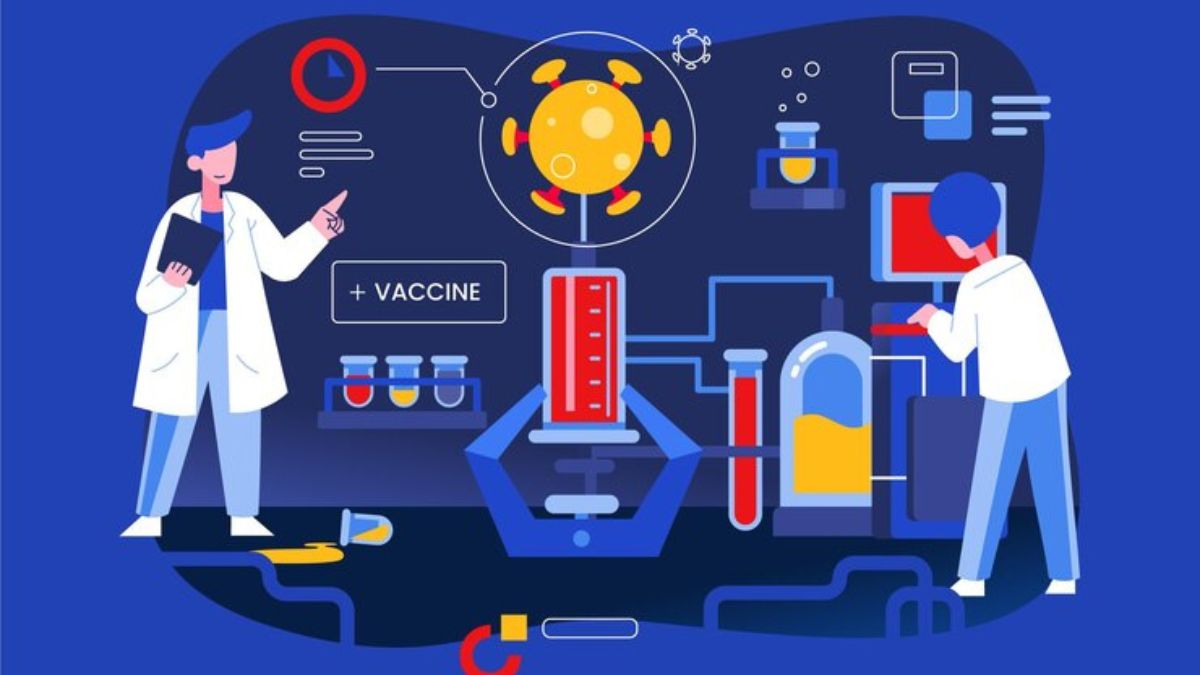TECHNOLOGY
Boosting Collaboration and Efficiency in totally Science GitLab

Welcome to the innovative world of collaborative science powered by GitLab! In this digital era, where teamwork and efficiency are paramount, GitLab stands out as a game-changer for scientists looking to streamline their research processes. Imagine a platform that not only fosters collaboration but also enhances productivity in totally Science GitLab projects. Let’s dive into the realm of possibilities that GitLab offers for scientific endeavors and discover how it can revolutionize the way we work together towards groundbreaking discoveries.
The Benefits of Using GitLab for Collaborative Science Projects
Are you tired of scattered project files and confusing version control systems? GitLab is here to revolutionize collaborative science projects. By centralizing all your work in one platform, GitLab streamlines communication among team members and ensures everyone is on the same page.
With GitLab’s features like issue tracking, merge requests, and code review tools, collaboration becomes seamless and efficient. Say goodbye to endless email threads and missed deadlines – GitLab keeps everything organized and accessible in a single place.
Need real-time feedback or want to track progress effortlessly? GitLab’s integrated CI/CD pipelines automate testing processes, saving time and reducing errors. This means more focus on groundbreaking research rather than tedious administrative tasks.
The benefits of using GitLab for collaborative science projects are clear: increased productivity, enhanced teamwork, and simplified workflows. Embrace the future of scientific collaboration with totally Science GitLab!
Features and Tools that Facilitate Team Collaboration on GitLab
GitLab offers a plethora of features and tools designed to streamline team collaboration on scientific projects. One key feature is the ability to create project boards, allowing teams to visualize tasks, track progress, and prioritize work effectively.
Another valuable tool is the merge request functionality, which enables seamless code review processes among team members. The built-in continuous integration and deployment pipelines help automate testing and deployment workflows, ensuring efficiency in the development process.
The Wiki feature allows for easy documentation and knowledge sharing within the team. Additionally, GitLab’s issue tracking system helps teams identify and resolve issues quickly while keeping all communication centralized.
With integrated chat capabilities through Slack or Mattermost, team members can communicate in real-time without leaving GitLab’s platform. These features empower scientific teams to collaborate more efficiently and effectively towards achieving their research goals.
Case Studies: How Organizations are Using GitLab for Efficient Science Projects
In the world of science, collaboration is key to advancing research and making breakthroughs. GitLab has become a go-to platform for organizations looking to streamline their collaborative efforts in scientific projects.
One case study involves a team of researchers from a leading university using GitLab to manage their data analysis workflows. By utilizing GitLab’s version control features, they were able to track changes, collaborate in real-time, and ensure the integrity of their research findings.
Another example is a biotech company leveraging GitLab for project management and code review processes. With GitLab’s built-in tools for continuous integration and deployment, they could automate testing procedures and accelerate the development cycle of new pharmaceutical products.
By implementing GitLab into their scientific workflows, these organizations have seen significant improvements in efficiency, communication among team members, and overall project outcomes. The future of collaborative science looks promising with platforms like GitLab driving innovation forward.
Tips for Maximizing Productivity and Efficiency on GitLab
Looking to boost productivity and efficiency on GitLab for your science projects? Here are some tips to help you make the most out of this collaborative platform.
First, create clear project milestones and timelines. Setting specific goals can keep your team focused and on track towards completion.
Utilize GitLab’s issue tracking feature to assign tasks, prioritize work, and monitor progress effectively. This helps streamline communication within the team.
Regularly update documentation on GitLab to ensure everyone is informed about the latest developments in the project. Clear documentation can save time and prevent misunderstandings.
Encourage frequent code reviews among team members to maintain high standards of quality in your project. Constructive feedback leads to better results.
Take advantage of integrations with other tools like Jira or Slack for seamless workflow management and communication across different platforms. Enhancing collaboration through integrations can improve overall efficiency on GitLab.
Challenges and Solutions for Integrating GitLab into Scientific Workflows
Integrating GitLab into scientific workflows can present some challenges for research teams. One common issue is the learning curve associated with adopting a new tool like GitLab, especially for scientists who may not have prior experience with version control systems. This hurdle can slow down initial progress and cause frustration among team members.
Another challenge is ensuring that all project data and code are properly managed and organized within GitLab to maintain transparency and reproducibility in research. Without clear guidelines and protocols in place, there’s a risk of confusion or accidental loss of important information.
To overcome these challenges, providing comprehensive training sessions on GitLab usage can help team members quickly get up to speed with the platform. Establishing standardized workflows and documentation practices within GitLab can also streamline collaboration and ensure that everyone is on the same page regarding project requirements.
By implementing these solutions, research teams can effectively integrate GitLab into their scientific workflows, boosting efficiency and collaboration throughout the project lifecycle.
Conclusion: The Future of Collaborative Science with GitLab
As we look ahead to the future of collaborative science with GitLab, the potential for innovation and advancement is truly exciting. With its robust features and tools designed specifically for team collaboration, GitLab has proven to be a game-changer in scientific workflows. By leveraging this platform effectively, organizations can streamline their processes, enhance communication among team members, and ultimately accelerate the pace of discovery.
As more research institutions and scientific teams recognize the value of using GitLab for their projects, we can expect to see even greater levels of efficiency and productivity in the field of science. By embracing this powerful tool and implementing best practices for collaboration, researchers can collaborate seamlessly across disciplines, share knowledge more effectively, and achieve groundbreaking results that have the potential to shape our understanding of the world around us.
In essence, GitLab is not just a repository management system; it is a catalyst for driving progress in science through enhanced collaboration and streamlined workflows. The future of collaborative science with GitLab is bright indeed – filled with endless possibilities for innovation, discovery, and transformation in the pursuit of knowledge.
TECHNOLOGY
The Rise of Po18: Why More People Are Flocking to This Unique Platform

Welcome to the next big thing in social media – Po18! Imagine a platform that combines the best features of your favorite apps, tailored for a unique community looking to connect, create, and inspire. Po18 isn’t just another social network; it’s a vibrant hub where individuals from all walks of life come together to share their stories, passions, and talents innovatively. Join us on this journey as we explore what makes Po18 stand out in the crowded world of social media.
The History of Po18 and How It Was Created
Po18, the rising star in the social media landscape, has an intriguing history that sets it apart from its competitors. The platform was born out of a desire to create a space where users could connect authentically and share their passions without the noise and distractions found on other platforms.
Founded by a team of tech-savvy visionaries who saw the potential for a new kind of social network, Po18 quickly gained traction among early adopters seeking a more meaningful online experience. With a focus on fostering genuine connections and sparking conversations around shared interests, Po18 carved out its own niche in the crowded world of social media.
The creators of Po18 were driven by a mission to empower users to express themselves freely and build communities based on mutual respect and understanding. This commitment to creating a positive online environment has been instrumental in shaping the platform’s growth and success over the years.
Features and Benefits of Po18
Po18 offers a unique platform that combines the best features of social media and networking sites. One of its key benefits is the ability to connect with like-minded individuals who share your interests, whether it’s music, art, fashion, or technology. Users can create and join groups based on their passions, fostering a sense of community and belonging.
Another standout feature of Po18 is its user-friendly interface that makes navigation smooth and intuitive. The platform also prioritizes user privacy and security, ensuring a safe space for sharing thoughts and ideas without fear of intrusion. Additionally, Po18 allows users to customize their profiles creatively with photos, videos, and links to showcase their personality.
Furthermore, Po18 integrates advanced algorithms that recommend relevant content based on individual preferences, enhancing the overall user experience. Whether you’re an aspiring artist looking for exposure or a tech enthusiast seeking insightful discussions – Po18 has something for everyone.
Success Stories from Po18 Users
Have you ever wondered what sets Po18 apart from other social media platforms? It’s not just about connecting with friends or sharing updates; it’s a place where real success stories come to life.
Users on Po18 have found new opportunities, whether it’s launching a business, gaining recognition for their art, or simply finding a supportive community. One user shared how they went from struggling artist to selling out galleries thanks to the exposure they gained on Po18.
Another user talked about how they discovered their passion for cooking through the platform and now run a successful food blog with thousands of followers. These success stories are not just isolated incidents – they are examples of the endless possibilities that await you on Po18.
So if you’re looking for a platform where your creativity can truly thrive and be celebrated, look no further than Po18. Join the community today and start writing your own success story!
Comparing Po18 to Other Social Media Platforms
When it comes to social media platforms, Po18 stands out from the crowd with its unique approach. Unlike other mainstream platforms, Po18 focuses on connecting people through their passions and interests rather than just casual interactions.
While platforms like Facebook and Instagram prioritize likes and followers, Po18 puts emphasis on meaningful connections based on shared hobbies or goals. This sets it apart as a more niche and authentic space for users to engage with like-minded individuals.
On Po18, users can join communities centered around specific topics or activities, fostering deeper relationships and discussions compared to the superficial interactions often seen on other platforms. The focus is not on popularity or trends but on genuine connections that add value to users’ lives.
By offering a more focused and intimate experience, Po18 provides an alternative to the noise and distractions of traditional social media. It’s a place where users can truly be themselves without feeling pressured to conform to societal expectations or standards set by influencers.
In essence, while other social media platforms may cater to the masses, Po18 caters to those seeking a more meaningful online community where they can share their passions with others who genuinely understand and appreciate them.
How to Get Started on Po18
Are you ready to dive into the exciting world of Po 18? Getting started on this innovative platform is a breeze. First, head over to the Po 18 website and create your account. It’s quick and easy – just enter some basic information, choose a username, and set up your profile.
Once you’re all signed up, take some time to explore the different features that Po 18 has to offer. From engaging with like-minded individuals in various communities to sharing your passions through posts and discussions, there’s something for everyone on Po18.
One of the best ways to get involved on Po 18 is by joining conversations and connecting with other users who share your interests. Don’t be shy – jump right in and start interacting with the vibrant community that makes Po 18 so special.
As you familiarize yourself with the platform, consider creating your own content to contribute to the diverse range of topics available on Po18. Whether it’s sharing personal stories, asking questions, or offering advice, there are endless possibilities for engagement on this dynamic platform.
The Future of Po18 and Its Impact on the Industry
As we peer into the future of Po 18, it’s clear that this platform is poised to make a significant impact on the industry. With its innovative approach to connecting people through shared interests and passions, Po 18 is revolutionizing how social media is experienced.
The continuous evolution of Po18 promises new features and enhancements that will further enhance user engagement and interaction. From personalized content recommendations to enhanced privacy settings, users can expect a seamless and tailored experience unlike any other.
Furthermore, the growing community on Po18 signifies a shift towards more meaningful connections online. By fostering genuine relationships based on common interests, Po 18 is creating a space where users can truly engage with like-minded individuals in a positive and supportive environment.
As Po18 continues to grow and innovate, its impact on the industry will be undeniable. The future holds endless possibilities for this unique platform, shaping the way we connect and interact online for years to come.
Conclusion: Why You Should Join the Po 18 Community
Joining the Po18 community opens up a world of opportunities for connecting with like-minded individuals, sharing your passions, and discovering new content. The platform’s unique approach to social media offers a refreshing alternative to traditional platforms, focusing on creativity and authenticity rather than popularity metrics. As Po 18 continues to grow and evolve, it is becoming increasingly clear why more people are flocking to this innovative platform.
So, if you’re looking for a new social media experience that values genuine connections and meaningful interactions, look no further than Po18. Join the community today and become part of a thriving network of individuals who share your interests and passions. Experience the rise of Po 18 firsthand and discover what sets it apart from the rest. Embrace change, embrace creativity – join Po 18 now!
TECHNOLOGY
5 Tips for Optimizing Performance in SSIS-950

Are you ready to supercharge the performance of your SSIS-950 projects? In the fast-paced world of data integration, optimizing efficiency is key. Today, we’re diving into 5 expert tips to help you maximize speed and effectiveness in SSIS-950. Let’s rev up those engines and get ready to take your data integration game to the next level!
Understanding Key Performance Indicators (KPIs)
Performance indicators are essential metrics used to evaluate the efficiency and effectiveness of a process, such as SSIS-950. In this context, KPIs provide valuable insights into how well your SSIS-950 packages are performing in terms of data integration tasks. Understanding these KPIs can help you identify areas for improvement and optimization within your SSIS-950 workflows.
Key performance indicators in SSIS-950 may include factors like data processing speed, resource utilization, memory usage, and package execution times. By analyzing these metrics, you can pinpoint bottlenecks or inefficiencies that may be hindering the overall performance of your ETL processes.
Having a clear understanding of KPIs allows you to make informed decisions when optimizing your SSIS-950 packages. It enables you to focus on specific areas that require attention and fine-tuning to enhance the overall performance and throughput of your data integration workflows.
Importance of Optimization in SSIS-950
Optimization plays a crucial role in the efficient functioning of SSIS-950. As data integration processes become more complex and demanding, the need to streamline performance becomes paramount. Optimization ensures that tasks are executed swiftly and accurately, leading to improved productivity and reliability.
By focusing on optimization strategies, users can enhance the overall speed and effectiveness of their SSIS-950 workflows. This not only saves time but also reduces unnecessary resource consumption, making operations more cost-effective in the long run. With optimized performance, organizations can meet tight deadlines and deliver high-quality results consistently.
Moreover, optimization helps in maximizing the capabilities of SSIS-950 by fine-tuning various components such as data flows, memory usage, and package maintenance. It enables users to harness the full potential of this powerful tool for seamless data integration across different systems and platforms.
In essence, prioritizing optimization in SSIS-950 is key to unlocking its full potential and ensuring smooth operation in today’s data-driven landscape. By adopting best practices for performance enhancement, users can stay ahead of challenges and drive greater efficiency in their data integration processes.
5 Tips for Optimizing Performance in SSIS-950:
When working with SSIS-950, optimizing performance is key to ensuring efficient data integration processes. Here are five essential tips to enhance the performance of your SSIS packages.
Utilize parallel processing by breaking down tasks into smaller chunks that can run simultaneously. This approach maximizes resource utilization and speeds up overall execution.
Optimize data flows by eliminating unnecessary columns and transformations. Streamlining the data flow path reduces processing time and enhances efficiency.
Use buffer sizing effectively to balance memory consumption with optimal performance. Adjusting buffer sizes based on the volume of data being processed can significantly improve package speed.
Next, monitor and tune memory usage regularly to prevent bottlenecks and optimize system resources for smooth operation.
Maintain and clean up packages routinely to remove redundant components or unused connections that may impact performance over time. Regular maintenance ensures optimal functioning of your SSIS environment.
A. Utilize Parallel Processing
One key tip for optimizing performance in SSIS-950 is to make the most of parallel processing. By dividing tasks into smaller sub-tasks that can be executed simultaneously, you can significantly speed up data integration processes.
Utilizing multiple threads to process data flows in parallel allows for better resource utilization and improved efficiency. This approach can help reduce overall processing time and enhance the scalability of your SSIS packages.
When setting up parallel processing in SSIS-950, it’s important to carefully design your control flow and data flow tasks to take advantage of this capability. By strategically configuring components like Parallel Loop Tasks or For Each Loop Containers, you can maximize the benefits of running tasks concurrently.
By implementing parallel processing effectively in your SSIS-950 workflows, you can boost performance, optimize resource usage, and streamline data integration operations.
B. Optimize Data Flows
Data flows are the lifeblood of SSIS-950, ensuring smooth movement and transformation of information within packages. To optimize data flows effectively, start by simplifying complex transformations that could slow down processing speed. Focus on reducing unnecessary columns in your data sources to streamline the flow and improve performance. Make use of conditional splits and lookups strategically to filter out irrelevant data early on in the process.
Consider implementing caching mechanisms for lookup operations to minimize database hits and boost efficiency. Utilize appropriate data types to ensure optimal storage and processing speeds throughout the pipeline. Keep a close eye on the volume of data passing through each component, adjusting settings as needed to prevent bottlenecks.
By fine-tuning your data flows with these optimization techniques, you can enhance overall performance in SSIS-950 and achieve faster execution times for your ETL processes.
C. Use Buffer Sizing Effectively
Buffer sizing plays a crucial role in optimizing performance in SSIS-950. By effectively managing buffer sizes, you can significantly enhance the efficiency of your data flows.
When configuring buffer sizes, it’s essential to strike a balance between allocating enough memory for optimal performance without unnecessarily consuming resources. A good practice is to start with default settings and then fine-tune based on specific requirements and workload characteristics.
Keep an eye on the size of your buffers during execution to ensure they are not too small or too large for the data being processed. Adjusting buffer sizes accordingly can help prevent issues like data spills and improve overall throughput.
Experiment with different buffer size configurations to find the sweet spot that maximizes performance for your particular ETL processes. Remember that what works best may vary depending on the complexity and volume of your data transformations.
By mastering the art of using buffer sizing effectively, you can unlock hidden potential in your SSIS-950 packages and pave the way for smoother and more efficient data integration workflows.
D. Monitor and Tune Memory Usage
Monitoring and tuning memory usage in SSIS-950 is crucial for optimal performance. By keeping an eye on memory consumption, you can identify bottlenecks and optimize resources efficiently.
Regularly checking memory usage metrics allows you to pinpoint areas where improvements can be made. This proactive approach helps in preventing potential issues before they impact the overall performance of your SSIS packages.
Tuning memory settings based on workload requirements ensures that resources are allocated appropriately, leading to smoother data processing operations. Fine-tuning these settings can significantly enhance the efficiency of your ETL processes.
Utilizing tools within SSIS-950 to monitor memory usage provides valuable insights into how your packages are utilizing system resources. This data-driven approach empowers you to make informed decisions when optimizing memory allocation for better performance outcomes.
Stay vigilant about monitoring and tuning memory usage to maintain a well-oiled SSIS environment that operates at its peak efficiency level. By proactively managing memory utilization, you set yourself up for success in handling complex data integration tasks seamlessly.
E. Regularly Maintain and Clean Up Packages
Regular maintenance and cleaning up of packages in SSIS-950 is crucial for optimizing performance. By regularly reviewing and tidying up your packages, you can ensure they are running efficiently and effectively. One way to do this is by removing any unnecessary components or tasks that may be slowing down the process.
Unused connections or variables should also be cleaned up to streamline the package and improve overall performance. It’s important to keep an eye on package dependencies and update them as needed to prevent any bottlenecks in the workflow.
Regularly organizing and structuring your packages can make a significant difference in how they perform. By keeping things tidy and well-maintained, you can avoid cluttered workflows that may impact processing speed. Don’t forget to clean out old logs, temporary files, or any other extraneous data that could be clogging up your system.
Incorporating regular maintenance into your routine will help ensure that your SSIS-950 packages are running at their optimal levels. Make it a habit to review, clean up, and maintain your packages consistently for smooth operations.
Common Challenges and How to Over
Common Challenges and How to Over
While SSIS-950 offers powerful capabilities for data integration and transformation, there are common challenges that users may face. Slow performance, memory issues, and inefficient data flows can hinder the overall efficiency of SSIS packages.
To overcome these challenges, it is essential to follow the optimization tips discussed in this article. By utilizing parallel processing, optimizing data flows, effectively managing buffer sizing, monitoring memory usage, and maintaining packages regularly, you can significantly improve performance in SSIS-950.
Remember that continuous monitoring and fine-tuning are key to ensuring optimal performance over time. By implementing these best practices and staying proactive in your approach to optimization, you can maximize the potential of SSIS-950 for seamless data integration processes.
TECHNOLOGY
Maximizing Productivity with Contact PlugboxLinux: Tips and Tricks for Success

Are you ready to revolutionize the way you manage your contacts and tasks? Say hello to Contact PlugboxLinux – the ultimate tool for maximizing productivity and efficiency! In a digital world filled with endless distractions, staying organized is key to success. With Contact PlugboxLinux, you can streamline your workflow, prioritize tasks, and take control of your schedule like never before. Get ready to supercharge your productivity and unlock your full potential with these tips and tricks for success!
The Benefits of Using Contact PlugboxLinux for Productivity
Are you looking for a game-changer in your productivity journey? Look no further than Contact PlugboxLinux. This powerful tool offers a plethora of benefits that can revolutionize the way you manage contacts and tasks.
One key advantage of Contact PlugboxLinux is its seamless integration of contact management and task tracking. Say goodbye to switching between multiple platforms – everything you need is conveniently housed in one place.
With Contact PlugboxLinux, staying organized has never been easier. You can categorize contacts, set reminders, and prioritize tasks with just a few clicks. This streamlined approach saves valuable time and ensures nothing falls through the cracks.
Furthermore, the customizable features allow you to tailor Contact PlugboxLinux to suit your unique workflow. Whether you prefer color-coded categories or personalized tags, this tool adapts to meet your individual needs.
In short, Contact PlugboxLinux empowers users to boost efficiency, enhance communication, and ultimately achieve more in less time. Ready to supercharge your productivity? Give it a try today!
Setting Up and Customizing Contact PlugboxLinux
Setting up and customizing Contact PlugboxLinux is a breeze with its user-friendly interface. To get started, simply download the software from their official website and follow the step-by-step installation guide. Once installed, you can personalize your contact lists by adding custom fields such as birthdays, notes, or tags to better organize your contacts.
Customizing the layout of your dashboard is also easy – rearrange widgets, adjust color schemes, and choose which information to display prominently. Take advantage of advanced customization options like setting up reminders for important tasks or events.
Tailor Contact PlugboxLinux to suit your workflow by creating specific categories or groups for different types of contacts. You can even integrate it with other productivity tools you use daily for seamless organization across platforms. Experiment with different settings until you find what works best for you!
Tips for Efficiently Managing Contacts and Tasks
Want to stay on top of your contacts and tasks without feeling overwhelmed? Here are some handy tips for efficiently managing them with Contact PlugboxLinux.
First, organize your contacts into categories or tags based on relationships or projects. This way, you can easily locate specific contacts when needed.
Set reminders for important tasks and follow-ups to ensure nothing slips through the cracks. Utilize the task management features to prioritize tasks based on urgency or deadlines.
Regularly update contact information to keep it current and accurate. Use notes section to jot down key details about each contact for quick reference.
Take advantage of search functionality to quickly find specific contacts or tasks instead of scrolling through a long list manually.
Schedule regular reviews of your contacts and tasks to reassess priorities and make necessary adjustments for optimal productivity.
Utilizing Automation Features to Save Time
Automation features in Contact PlugboxLinux can be a game-changer when it comes to saving time and streamlining your workflow. By setting up automated reminders for important tasks or follow-ups, you can ensure that nothing falls through the cracks. You can also automate email responses to common inquiries, freeing up your time for more meaningful work.
Another powerful automation feature is the ability to schedule emails to be sent at a later time. This can be particularly useful if you want to reach out to contacts in different time zones or during peak engagement hours. Additionally, automating data entry processes can help eliminate manual errors and speed up repetitive tasks.
By taking advantage of these automation features, you can focus on high-value activities that require your expertise and creativity. Contact PlugboxLinux empowers you to work smarter, not harder.
Integrating Contact PlugboxLinux with Other Productivity Tools
Are you looking to supercharge your productivity by integrating Contact PlugboxLinux with other powerful tools? Look no further! By seamlessly connecting your contact management system with popular productivity apps like Trello, Slack, and Google Calendar, you can streamline your workflow and stay organized like never before.
Syncing Contact PlugboxLinux with task management tools allows you to create tasks directly from contact profiles, ensuring that important follow-ups and reminders are never missed. Need to collaborate with team members? Integration with communication platforms like Slack makes it easy to share contacts and discuss strategies in real-time.
Furthermore, linking Contact PlugboxLinux with calendar applications enables you to schedule meetings and set deadlines without ever leaving the platform. Say goodbye to switching between multiple tabs – everything you need is now conveniently consolidated in one place.
Troubleshooting Common Issues and Updates
Encountering common issues and updates while using Contact PlugboxLinux can be frustrating, but with a few troubleshooting tips, you can overcome them swiftly. One frequent problem users face is syncing errors between devices – ensure all devices are connected to the same network and restart the application. If you notice slow performance, check for any pending software updates or clear cache memory to improve speed.
In case of login issues, double-check your credentials and verify your internet connection strength. Updates are crucial for optimal performance; regularly check for new versions of Contact PlugboxLinux to access the latest features and bug fixes. Remember to back up your data before updating to prevent any potential loss in information.
By staying proactive with these troubleshooting steps, you can keep your productivity on track without interruptions caused by technical glitches or outdated software versions.
Success Stories: Real-Life Examples of Increased Productivity with Contact PlugboxLinux
Imagine Sarah, a busy entrepreneur juggling multiple business projects simultaneously. With Contact PlugboxLinux, she streamlined her contact management and task organization seamlessly. By customizing the platform to fit her specific needs, Sarah efficiently managed her contacts and tasks with ease.
Utilizing the automation features of Contact PlugboxLinux, Sarah saved valuable time by setting up reminders and automated follow-ups. This allowed her to focus on high-priority tasks without missing important deadlines or meetings.
Integrating Contact PlugboxLinux with other productivity tools such as email clients and calendar apps further enhanced Sarah’s workflow efficiency. The seamless synchronization ensured that all her information was up-to-date across various platforms.
With the help of Contact PlugboxLinux, Sarah experienced a significant increase in productivity and overall business success. From improved communication with clients to better task management, this tool became an essential part of her daily operations.
Conclusion
As you can see, ContactPlugboxLinux is a powerful tool that can greatly enhance your productivity and organization. By utilizing its features effectively, setting up customized workflows, and integrating it with other tools, you can streamline your tasks and contacts for maximum efficiency.
Remember to take advantage of automation features to save time and troubleshoot any issues that may arise promptly. With Contact PlugboxLinux by your side, you can increase your productivity levels and achieve success in managing your contacts and tasks more efficiently than ever before.
Start maximizing your productivity today with ContactPlugboxLinux!
-

 LOVE MESSAGES7 months ago
LOVE MESSAGES7 months agoSweet Love Messages for Her to Make Her Smile
-

 LOVE MESSAGES7 months ago
LOVE MESSAGES7 months ago100 Romantic Good Evening Messages For Her & Him
-

 LOVE MESSAGES7 months ago
LOVE MESSAGES7 months agoRomantic Love Messages For My Husband With Images
-

 LOVE MESSAGES7 months ago
LOVE MESSAGES7 months ago50 Just Checking on You Text Messages for Him & Her
-

 LOVE MESSAGES7 months ago
LOVE MESSAGES7 months agoSweet Love Messages For My Wife With Images
-

 LOVE MESSAGES7 months ago
LOVE MESSAGES7 months ago50 Cute Good Night Sweet Dreams Messages For Lovers
-

 LOVE MESSAGES7 months ago
LOVE MESSAGES7 months ago25 Romantic I Love You Messages for Her
-

 LOVE MESSAGES7 months ago
LOVE MESSAGES7 months agoLong Good Morning Messages to Make Her Fall in Love
